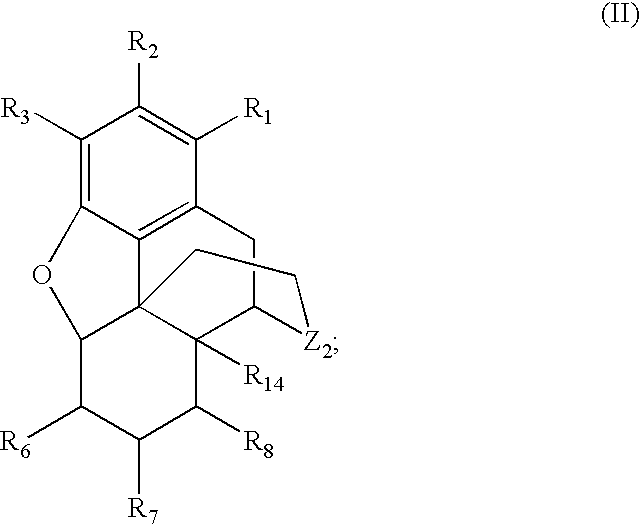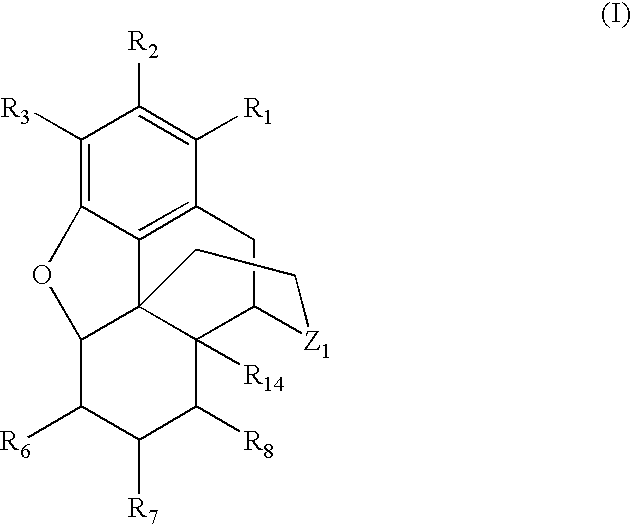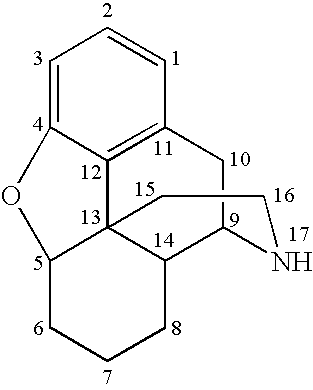Preparation of N-Alkylated Opiates by Reductive Amination
- Summary
- Abstract
- Description
- Claims
- Application Information
AI Technical Summary
Benefits of technology
Problems solved by technology
Method used
Image
Examples
example 1
Synthesis of Buprenorphine
[0072]The overall synthesis of buprenorphine from NOR-buprenorphine is depicted in the following reaction scheme:
[0073]NOR-Buprenorphine (3.67 g, 8.87 mmol) was added to acetonitrile (30 mL). Cyclopropanecarboxaldehyde (1.25 g, 17.84 mmol) was added and the slurry stirred for 1 hour at room temperature. At that time, a 5 to 2 mixture of 98% formic acid / triethylamine [prepared by adding 98% formic acid (5.34 g, 116 mmol) to triethylamine (4.70 g, 46.4 mmol)] in 10 mL of acetonitrile was added. Dichloro(p-cymene)ruthenium (II) dimer (27 mg) was added followed by (1S,2S)-(+)-N-tosyl-diphenylethylenediamine (32 mg). The reaction was purged by nitrogen gas for 30 minutes and became homogeneous after this time. A steady flow of nitrogen was allowed to pass over the reaction. The reaction was stirred for 36 hours at room temperature. Evaporation of the mixture produced a thick oil (5.34 g). 10 mL acetonitrile was added and stirred at room temperature for 1 hour, a...
example 2
Synthesis of Naltrexone from Noroxymorphone
[0074]The overall synthesis of naltrexone from noroxymorphone is depicted in the following reaction scheme:
Example 2(a)
Synthesis of 6-Ketalnoroxymorphone from Noroxymorphone
[0075]
[0076]Noroxymorphone (3.30 g, 11.5 mmole) was slurried with ethylene glycol (14.26 g, 230 mmol, 12.85 mL). Methanesulfonic acid (2.21 g, 23.0 mmol, 1.49 mL) was then added dropwise. The reaction was allowed to stir overnight (16 h) at room temperature. Then, the reaction was poured slowly into 29% NH3 / H2O (50 mL) and stirred for 2 hours at room temperature where a white precipitate appeared. 6-Ketal Noroxymorphone (3.75 g, 98.5% yield) was isolated by filtration of the reaction mixture, washing the solid with distilled water (50 mL), and drying under reduced pressure (48 h, 25° C., 1 torr). HPLC analysis indicated 99.0% 6-ketalnoroxymorphone.
Example 2(b)
Synthesis of 6-Ketal Naltrexone from 6-Ketalnoroxymorphone
[0077]
[0078]6-ketalnoroxymorphone (0.95 g, 3.0 mmol), c...
example 2 (
Example 2(c)
Synthesis of Naltrexone from 6-ketal Naltrexone
[0079]
[0080]6-ketal naltrexone (1.06 g, 2.76 mmol) was added to a stirred solution of 88% HCO2H (5.0 mL) and distilled water (1.0 mL). After stirring for 2 hours at room temperature, the reaction was complete. The reaction mixture was slowly added to 30 mL 29% NH3 / H2O, and a white precipitate formed. The white precipitate was isolated by filtration, washed with distilled water (5.0 mL), and dried yielding naltrexone (895 mg, 95% yield). HPLC analysis=99.0%.
PUM
 Login to View More
Login to View More Abstract
Description
Claims
Application Information
 Login to View More
Login to View More - R&D
- Intellectual Property
- Life Sciences
- Materials
- Tech Scout
- Unparalleled Data Quality
- Higher Quality Content
- 60% Fewer Hallucinations
Browse by: Latest US Patents, China's latest patents, Technical Efficacy Thesaurus, Application Domain, Technology Topic, Popular Technical Reports.
© 2025 PatSnap. All rights reserved.Legal|Privacy policy|Modern Slavery Act Transparency Statement|Sitemap|About US| Contact US: help@patsnap.com



